5BUS1008 Project Planning and Control: Flexioffice Project Report
VerifiedAdded on 2023/04/11
|13
|2265
|458
Report
AI Summary
This project initiation document outlines the plan for developing ‘Flexioffice’ spaces in Watford, UK, by constructing an office building on top of an existing warehouse. The project will adhere to PMBOK guidelines and includes a business objective to launch a successful pilot project for Flexioffice, aiming to enter the commercial real-estate market. Key objectives include identifying the target demographic, creating a detailed project plan, and installing necessary telecommunication and IT infrastructure within budgetary and time constraints. The project scope covers researching existing flex office providers, surveying potential users, designing office spaces, and ensuring essential services are functional. Constraints involve utilizing the existing warehouse structure and completing the project on time and within budget. The document also includes assumptions, a layout plan, and a schedule network diagram to guide the project's execution. Desklib provides access to this document along with other solved assignments and study resources.

Project Initiation Document
Executive Summary
The project requires development of ‘Flexioffice’ spaces in Watford area in United Kingdom.
The office building would be constructed on top of an existing Warehouse. The project shall
be planned and managed using standard project management principles. The principles and
guidelines as outlined by PMBOK shall be used to manage the project. The project report
presented below begins with a brief introduction to the project that sets out the background
needed for the project. Moving ahead, the report will outline the business goals for the
project. Next in line in the report are the objectives that are needed for the project to be
successful. The project will also talk about some of the constraints that bound the project.
Also, the project would list out all of the assumptions that have been taken into consideration
for the project. The scope document in the report lays down the core boundaries for the
project as to what is and what is not to be done in the project.
1
Executive Summary
The project requires development of ‘Flexioffice’ spaces in Watford area in United Kingdom.
The office building would be constructed on top of an existing Warehouse. The project shall
be planned and managed using standard project management principles. The principles and
guidelines as outlined by PMBOK shall be used to manage the project. The project report
presented below begins with a brief introduction to the project that sets out the background
needed for the project. Moving ahead, the report will outline the business goals for the
project. Next in line in the report are the objectives that are needed for the project to be
successful. The project will also talk about some of the constraints that bound the project.
Also, the project would list out all of the assumptions that have been taken into consideration
for the project. The scope document in the report lays down the core boundaries for the
project as to what is and what is not to be done in the project.
1
Paraphrase This Document
Need a fresh take? Get an instant paraphrase of this document with our AI Paraphraser

Project Initiation Document
Table of Contents
Introduction................................................................................................................................3
Business Objective.....................................................................................................................3
Project Objective........................................................................................................................4
Constraints.................................................................................................................................4
Assumptions...............................................................................................................................4
Scope..........................................................................................................................................5
Functionality of the flexible office building..............................................................................6
Layout plan................................................................................................................................7
Schedule and network diagram..................................................................................................9
Scope........................................................................................................................................11
References................................................................................................................................13
2
Table of Contents
Introduction................................................................................................................................3
Business Objective.....................................................................................................................3
Project Objective........................................................................................................................4
Constraints.................................................................................................................................4
Assumptions...............................................................................................................................4
Scope..........................................................................................................................................5
Functionality of the flexible office building..............................................................................6
Layout plan................................................................................................................................7
Schedule and network diagram..................................................................................................9
Scope........................................................................................................................................11
References................................................................................................................................13
2
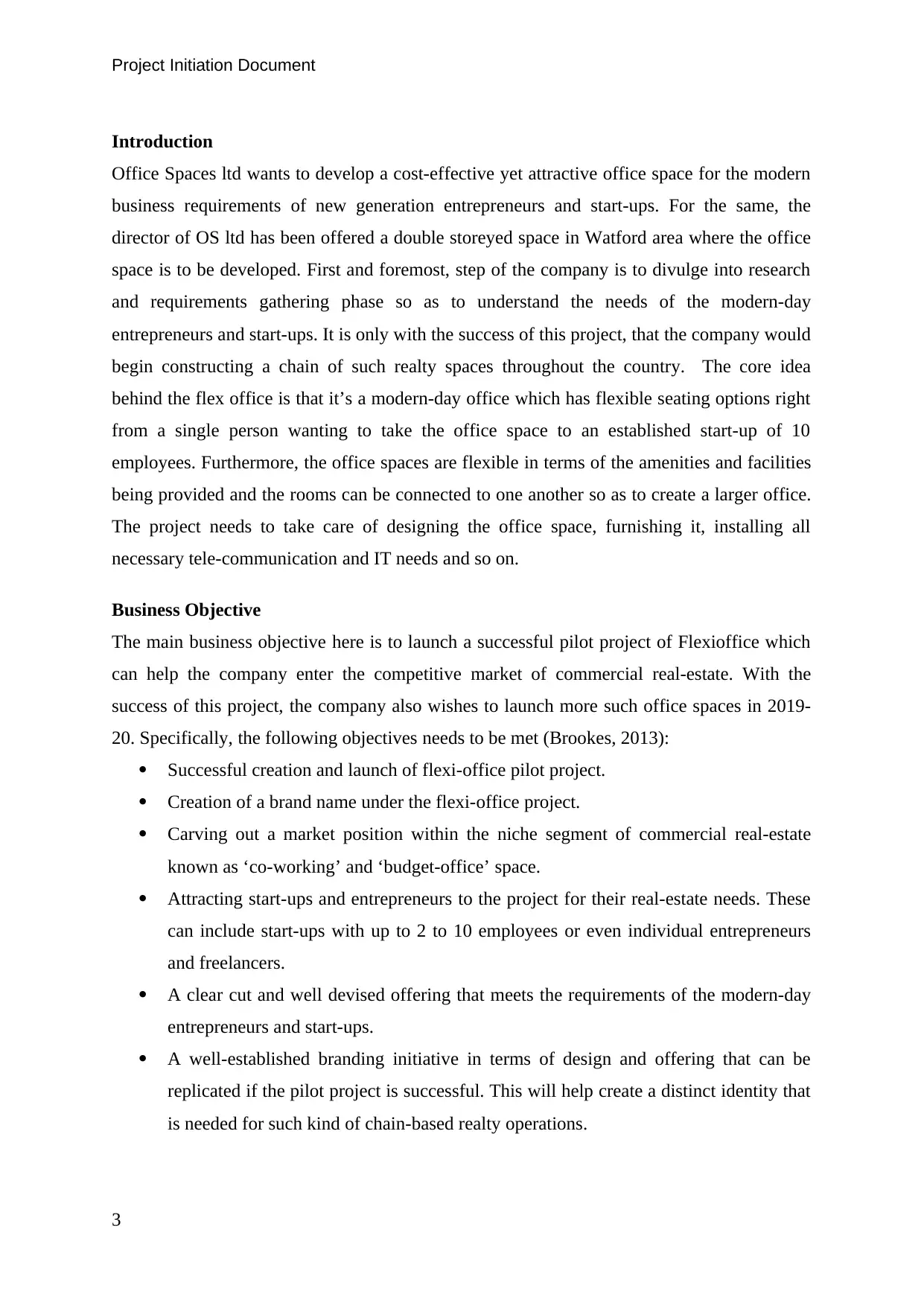
Project Initiation Document
Introduction
Office Spaces ltd wants to develop a cost-effective yet attractive office space for the modern
business requirements of new generation entrepreneurs and start-ups. For the same, the
director of OS ltd has been offered a double storeyed space in Watford area where the office
space is to be developed. First and foremost, step of the company is to divulge into research
and requirements gathering phase so as to understand the needs of the modern-day
entrepreneurs and start-ups. It is only with the success of this project, that the company would
begin constructing a chain of such realty spaces throughout the country. The core idea
behind the flex office is that it’s a modern-day office which has flexible seating options right
from a single person wanting to take the office space to an established start-up of 10
employees. Furthermore, the office spaces are flexible in terms of the amenities and facilities
being provided and the rooms can be connected to one another so as to create a larger office.
The project needs to take care of designing the office space, furnishing it, installing all
necessary tele-communication and IT needs and so on.
Business Objective
The main business objective here is to launch a successful pilot project of Flexioffice which
can help the company enter the competitive market of commercial real-estate. With the
success of this project, the company also wishes to launch more such office spaces in 2019-
20. Specifically, the following objectives needs to be met (Brookes, 2013):
Successful creation and launch of flexi-office pilot project.
Creation of a brand name under the flexi-office project.
Carving out a market position within the niche segment of commercial real-estate
known as ‘co-working’ and ‘budget-office’ space.
Attracting start-ups and entrepreneurs to the project for their real-estate needs. These
can include start-ups with up to 2 to 10 employees or even individual entrepreneurs
and freelancers.
A clear cut and well devised offering that meets the requirements of the modern-day
entrepreneurs and start-ups.
A well-established branding initiative in terms of design and offering that can be
replicated if the pilot project is successful. This will help create a distinct identity that
is needed for such kind of chain-based realty operations.
3
Introduction
Office Spaces ltd wants to develop a cost-effective yet attractive office space for the modern
business requirements of new generation entrepreneurs and start-ups. For the same, the
director of OS ltd has been offered a double storeyed space in Watford area where the office
space is to be developed. First and foremost, step of the company is to divulge into research
and requirements gathering phase so as to understand the needs of the modern-day
entrepreneurs and start-ups. It is only with the success of this project, that the company would
begin constructing a chain of such realty spaces throughout the country. The core idea
behind the flex office is that it’s a modern-day office which has flexible seating options right
from a single person wanting to take the office space to an established start-up of 10
employees. Furthermore, the office spaces are flexible in terms of the amenities and facilities
being provided and the rooms can be connected to one another so as to create a larger office.
The project needs to take care of designing the office space, furnishing it, installing all
necessary tele-communication and IT needs and so on.
Business Objective
The main business objective here is to launch a successful pilot project of Flexioffice which
can help the company enter the competitive market of commercial real-estate. With the
success of this project, the company also wishes to launch more such office spaces in 2019-
20. Specifically, the following objectives needs to be met (Brookes, 2013):
Successful creation and launch of flexi-office pilot project.
Creation of a brand name under the flexi-office project.
Carving out a market position within the niche segment of commercial real-estate
known as ‘co-working’ and ‘budget-office’ space.
Attracting start-ups and entrepreneurs to the project for their real-estate needs. These
can include start-ups with up to 2 to 10 employees or even individual entrepreneurs
and freelancers.
A clear cut and well devised offering that meets the requirements of the modern-day
entrepreneurs and start-ups.
A well-established branding initiative in terms of design and offering that can be
replicated if the pilot project is successful. This will help create a distinct identity that
is needed for such kind of chain-based realty operations.
3
⊘ This is a preview!⊘
Do you want full access?
Subscribe today to unlock all pages.

Trusted by 1+ million students worldwide
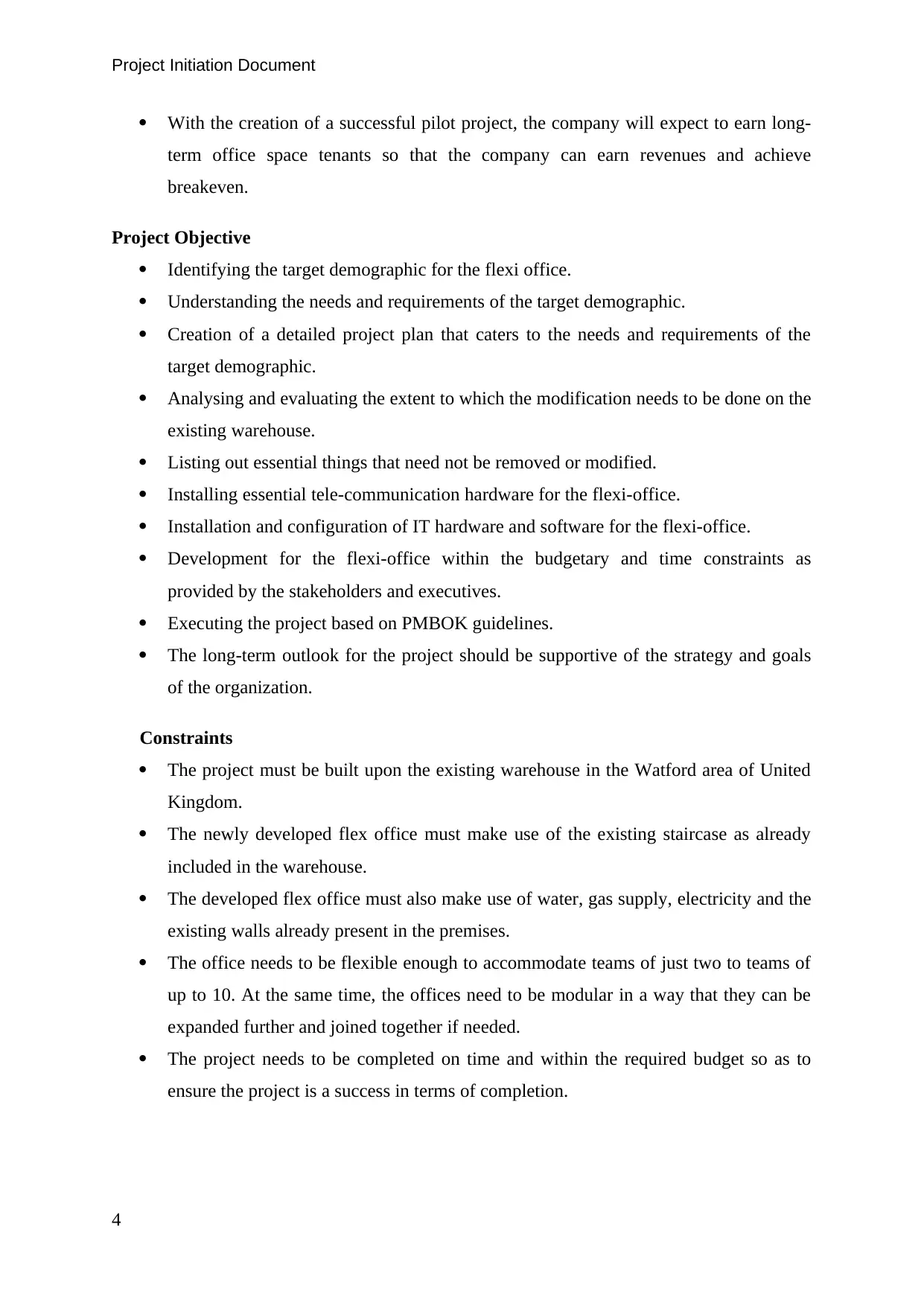
Project Initiation Document
With the creation of a successful pilot project, the company will expect to earn long-
term office space tenants so that the company can earn revenues and achieve
breakeven.
Project Objective
Identifying the target demographic for the flexi office.
Understanding the needs and requirements of the target demographic.
Creation of a detailed project plan that caters to the needs and requirements of the
target demographic.
Analysing and evaluating the extent to which the modification needs to be done on the
existing warehouse.
Listing out essential things that need not be removed or modified.
Installing essential tele-communication hardware for the flexi-office.
Installation and configuration of IT hardware and software for the flexi-office.
Development for the flexi-office within the budgetary and time constraints as
provided by the stakeholders and executives.
Executing the project based on PMBOK guidelines.
The long-term outlook for the project should be supportive of the strategy and goals
of the organization.
Constraints
The project must be built upon the existing warehouse in the Watford area of United
Kingdom.
The newly developed flex office must make use of the existing staircase as already
included in the warehouse.
The developed flex office must also make use of water, gas supply, electricity and the
existing walls already present in the premises.
The office needs to be flexible enough to accommodate teams of just two to teams of
up to 10. At the same time, the offices need to be modular in a way that they can be
expanded further and joined together if needed.
The project needs to be completed on time and within the required budget so as to
ensure the project is a success in terms of completion.
4
With the creation of a successful pilot project, the company will expect to earn long-
term office space tenants so that the company can earn revenues and achieve
breakeven.
Project Objective
Identifying the target demographic for the flexi office.
Understanding the needs and requirements of the target demographic.
Creation of a detailed project plan that caters to the needs and requirements of the
target demographic.
Analysing and evaluating the extent to which the modification needs to be done on the
existing warehouse.
Listing out essential things that need not be removed or modified.
Installing essential tele-communication hardware for the flexi-office.
Installation and configuration of IT hardware and software for the flexi-office.
Development for the flexi-office within the budgetary and time constraints as
provided by the stakeholders and executives.
Executing the project based on PMBOK guidelines.
The long-term outlook for the project should be supportive of the strategy and goals
of the organization.
Constraints
The project must be built upon the existing warehouse in the Watford area of United
Kingdom.
The newly developed flex office must make use of the existing staircase as already
included in the warehouse.
The developed flex office must also make use of water, gas supply, electricity and the
existing walls already present in the premises.
The office needs to be flexible enough to accommodate teams of just two to teams of
up to 10. At the same time, the offices need to be modular in a way that they can be
expanded further and joined together if needed.
The project needs to be completed on time and within the required budget so as to
ensure the project is a success in terms of completion.
4
Paraphrase This Document
Need a fresh take? Get an instant paraphrase of this document with our AI Paraphraser
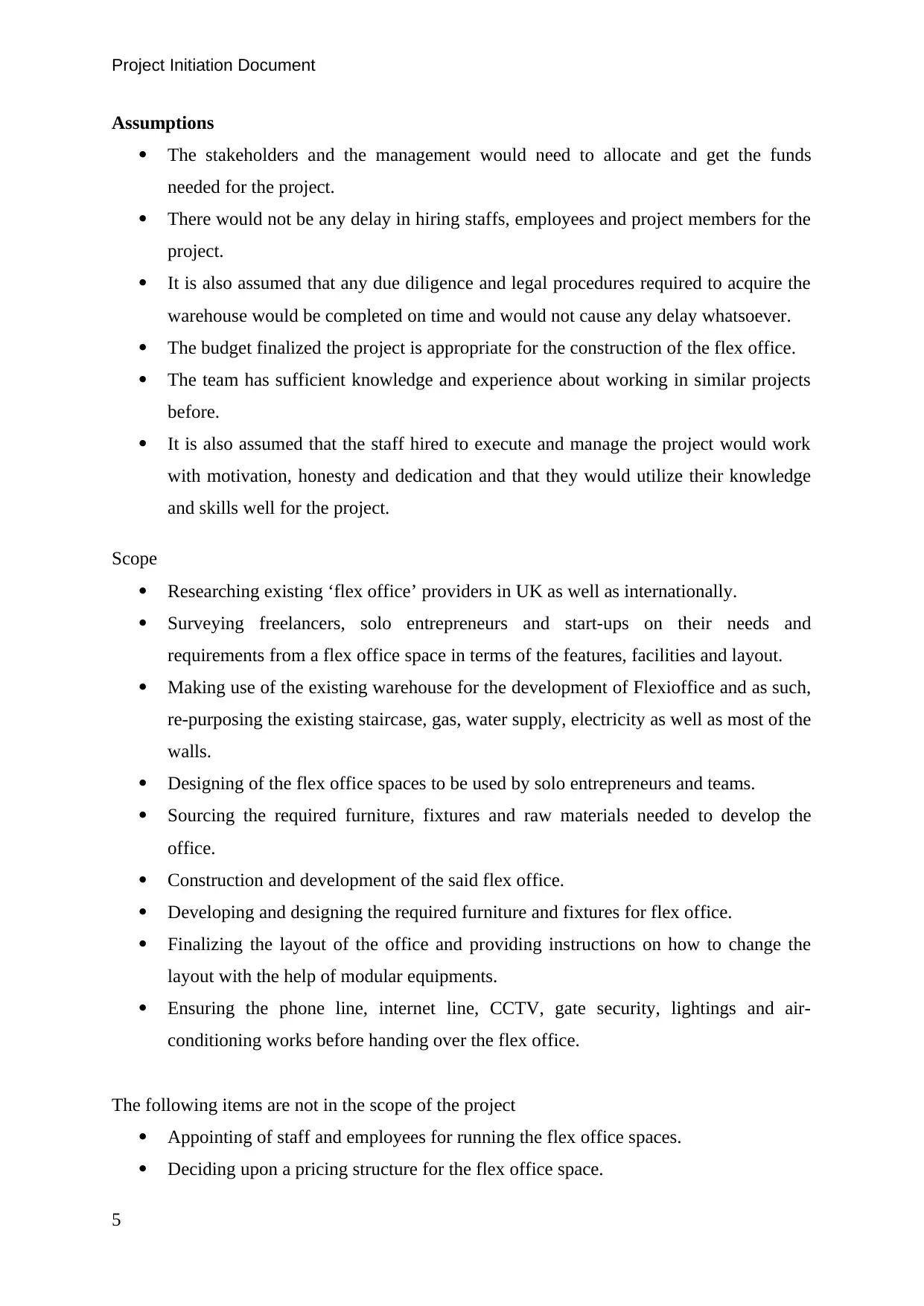
Project Initiation Document
Assumptions
The stakeholders and the management would need to allocate and get the funds
needed for the project.
There would not be any delay in hiring staffs, employees and project members for the
project.
It is also assumed that any due diligence and legal procedures required to acquire the
warehouse would be completed on time and would not cause any delay whatsoever.
The budget finalized the project is appropriate for the construction of the flex office.
The team has sufficient knowledge and experience about working in similar projects
before.
It is also assumed that the staff hired to execute and manage the project would work
with motivation, honesty and dedication and that they would utilize their knowledge
and skills well for the project.
Scope
Researching existing ‘flex office’ providers in UK as well as internationally.
Surveying freelancers, solo entrepreneurs and start-ups on their needs and
requirements from a flex office space in terms of the features, facilities and layout.
Making use of the existing warehouse for the development of Flexioffice and as such,
re-purposing the existing staircase, gas, water supply, electricity as well as most of the
walls.
Designing of the flex office spaces to be used by solo entrepreneurs and teams.
Sourcing the required furniture, fixtures and raw materials needed to develop the
office.
Construction and development of the said flex office.
Developing and designing the required furniture and fixtures for flex office.
Finalizing the layout of the office and providing instructions on how to change the
layout with the help of modular equipments.
Ensuring the phone line, internet line, CCTV, gate security, lightings and air-
conditioning works before handing over the flex office.
The following items are not in the scope of the project
Appointing of staff and employees for running the flex office spaces.
Deciding upon a pricing structure for the flex office space.
5
Assumptions
The stakeholders and the management would need to allocate and get the funds
needed for the project.
There would not be any delay in hiring staffs, employees and project members for the
project.
It is also assumed that any due diligence and legal procedures required to acquire the
warehouse would be completed on time and would not cause any delay whatsoever.
The budget finalized the project is appropriate for the construction of the flex office.
The team has sufficient knowledge and experience about working in similar projects
before.
It is also assumed that the staff hired to execute and manage the project would work
with motivation, honesty and dedication and that they would utilize their knowledge
and skills well for the project.
Scope
Researching existing ‘flex office’ providers in UK as well as internationally.
Surveying freelancers, solo entrepreneurs and start-ups on their needs and
requirements from a flex office space in terms of the features, facilities and layout.
Making use of the existing warehouse for the development of Flexioffice and as such,
re-purposing the existing staircase, gas, water supply, electricity as well as most of the
walls.
Designing of the flex office spaces to be used by solo entrepreneurs and teams.
Sourcing the required furniture, fixtures and raw materials needed to develop the
office.
Construction and development of the said flex office.
Developing and designing the required furniture and fixtures for flex office.
Finalizing the layout of the office and providing instructions on how to change the
layout with the help of modular equipments.
Ensuring the phone line, internet line, CCTV, gate security, lightings and air-
conditioning works before handing over the flex office.
The following items are not in the scope of the project
Appointing of staff and employees for running the flex office spaces.
Deciding upon a pricing structure for the flex office space.
5

Project Initiation Document
The project team is also not responsible for marketing the said office space to the
target demographic.
The team is also not responsible to modify the structure and layout of the rooms once
the handover has taken place.
The scope also does not cover the maintenance work if any needed post-handover of
the completed flex office spaces project.
Functionality of the flexible office building
Following are key functionalities of the proposed flexi-office (Ponnappa, 2014):
The area or space can be changed as per the requirement of staff.
The flexible office will reduce the total cost of the office. There will be only single
monthly bill which will include rent, furnishings, reception and IT support, office
cleaning services and office maintenance. All these things are included one monthly
fixed price.
Flexible offices provide fast move-in ability to the clients. They can start using office
within few hours of moving in.
There are no long-terms contract. The client can go for monthly contracts which can
be even changed as per the scaling requirements of client.
6
The project team is also not responsible for marketing the said office space to the
target demographic.
The team is also not responsible to modify the structure and layout of the rooms once
the handover has taken place.
The scope also does not cover the maintenance work if any needed post-handover of
the completed flex office spaces project.
Functionality of the flexible office building
Following are key functionalities of the proposed flexi-office (Ponnappa, 2014):
The area or space can be changed as per the requirement of staff.
The flexible office will reduce the total cost of the office. There will be only single
monthly bill which will include rent, furnishings, reception and IT support, office
cleaning services and office maintenance. All these things are included one monthly
fixed price.
Flexible offices provide fast move-in ability to the clients. They can start using office
within few hours of moving in.
There are no long-terms contract. The client can go for monthly contracts which can
be even changed as per the scaling requirements of client.
6
⊘ This is a preview!⊘
Do you want full access?
Subscribe today to unlock all pages.

Trusted by 1+ million students worldwide
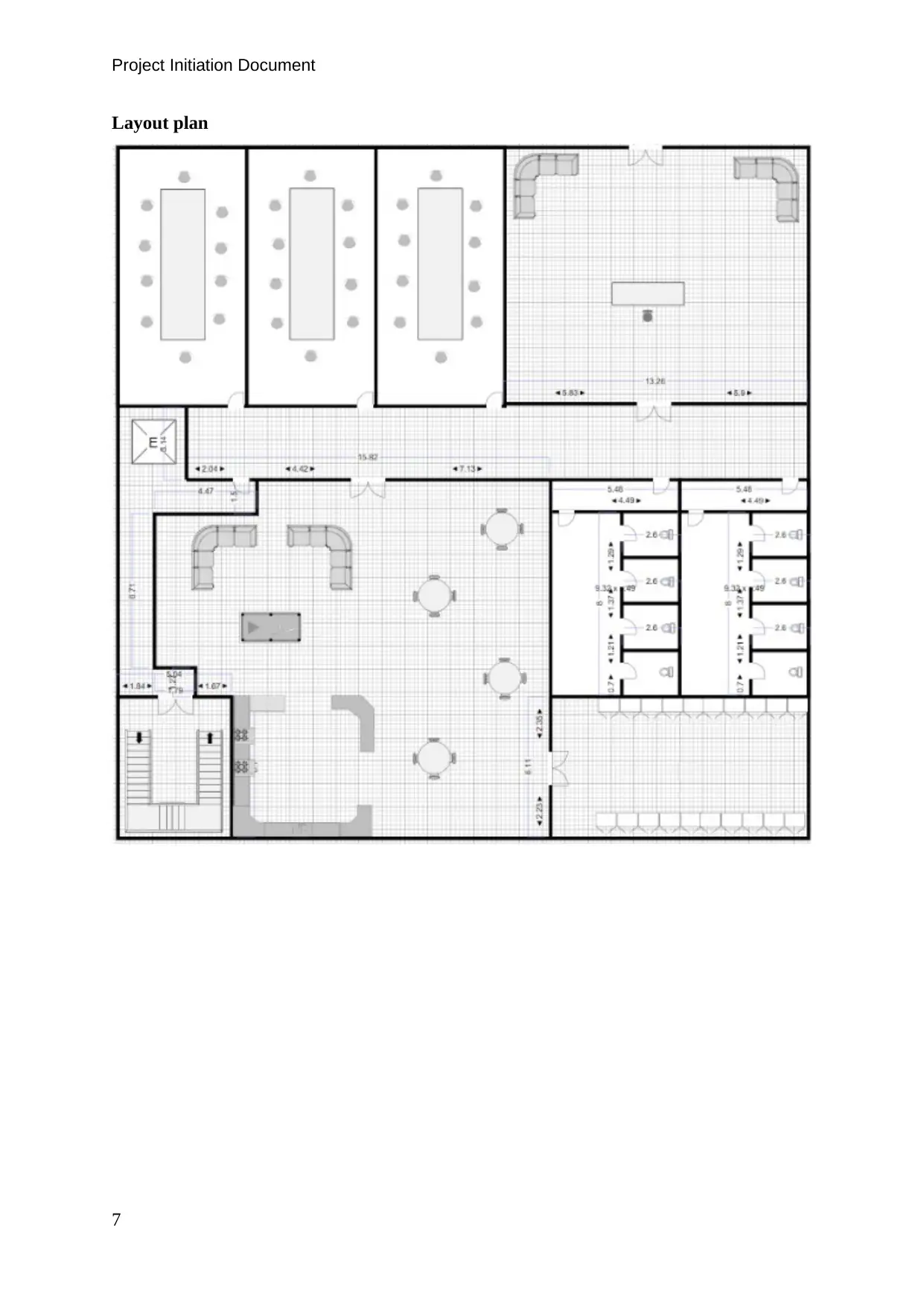
Project Initiation Document
Layout plan
7
Layout plan
7
Paraphrase This Document
Need a fresh take? Get an instant paraphrase of this document with our AI Paraphraser
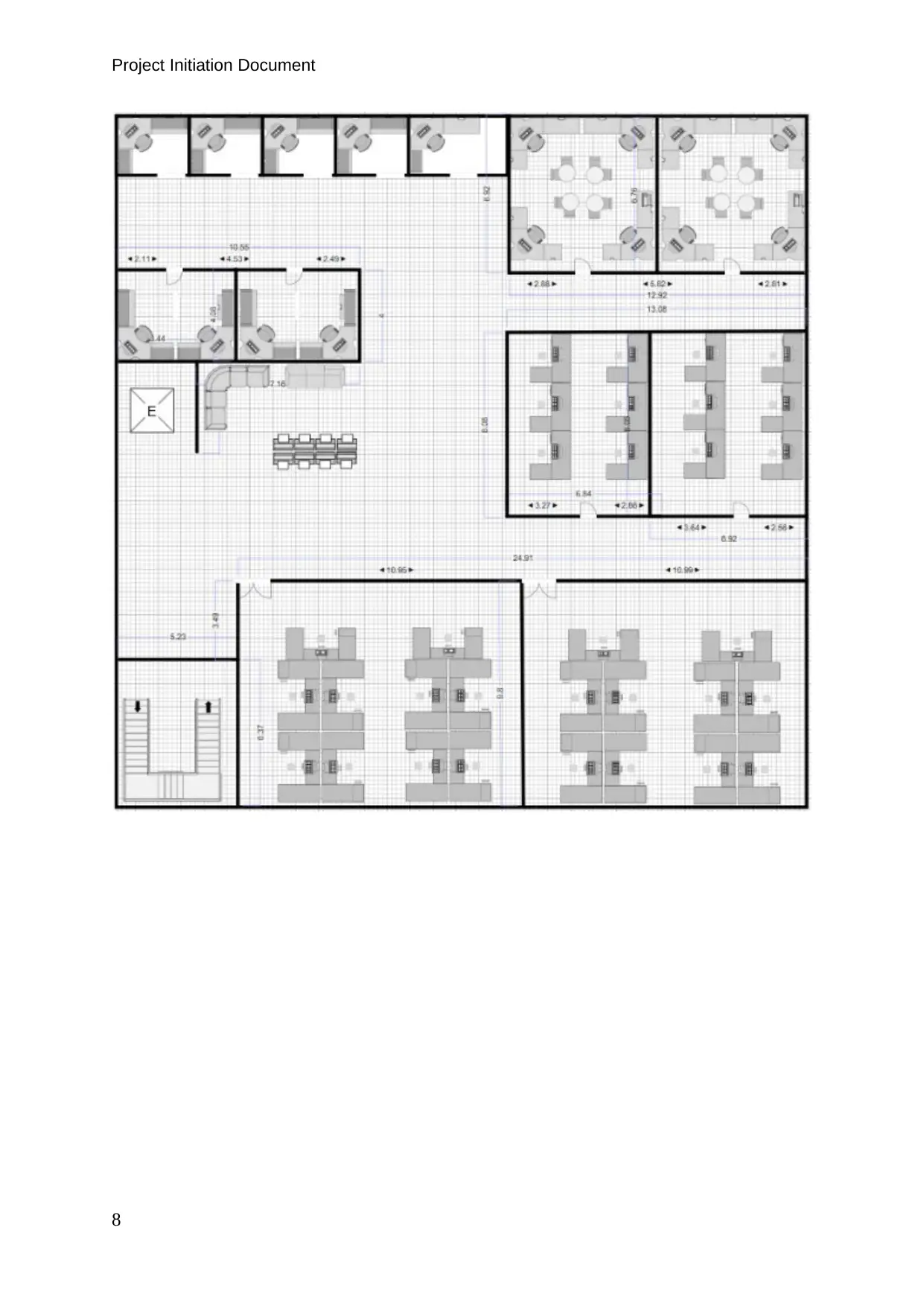
Project Initiation Document
8
8

Project Initiation Document
Schedule and network diagram
WBS Task Name Duration Predecessors
1 Flexi office development project 152 days
1.1 Project conceptualization 24 days
1.1.1 Research 9 days
1.1.1.1 Market research 5 days
1.1.1.2 Project viability 4 days 4
1.1.1.3 User requirements 4 days 4
1.1.1.4 Supervisors requirements 4 days 4
1.1.1.5 Inventory requirements 4 days 4
1.1.2 Planning 15 days
1.1.2.1 Identify reconfigurations 10 days 5,6,7,8
1.1.2.2 Office layouts 5 days 10
1.1.2.3 Office plan buildings 5 days 10
1.1.2.4 Office plan picking 5 days 10
1.1.2.5 Get plan approval 2 days 10
1.2 Vendor selection 22 days
1.2.1 Research contractors 5 days 11,12,13,14
1.2.2 Schedule site visits 3 days 16
1.2.3 Get contractor quotation 7 days 17
1.2.4 Negotiate price 3 days 18
1.2.5 Get quote approval 4 days 19
1.3 Refurbishment 45 days
1.3.1 Structural 12 days
1.3.1.1 Purchase materials 5 days 20
1.3.1.2 Site inspectors liaising 4 days 23
1.3.1.3 Monitor work progress 3 days 24
1.3.2 Electrical 18 days
1.3.2.1 Purchase materials 4 days 25
1.3.2.2 Re-configure electrical
system
5 days 27
9
Schedule and network diagram
WBS Task Name Duration Predecessors
1 Flexi office development project 152 days
1.1 Project conceptualization 24 days
1.1.1 Research 9 days
1.1.1.1 Market research 5 days
1.1.1.2 Project viability 4 days 4
1.1.1.3 User requirements 4 days 4
1.1.1.4 Supervisors requirements 4 days 4
1.1.1.5 Inventory requirements 4 days 4
1.1.2 Planning 15 days
1.1.2.1 Identify reconfigurations 10 days 5,6,7,8
1.1.2.2 Office layouts 5 days 10
1.1.2.3 Office plan buildings 5 days 10
1.1.2.4 Office plan picking 5 days 10
1.1.2.5 Get plan approval 2 days 10
1.2 Vendor selection 22 days
1.2.1 Research contractors 5 days 11,12,13,14
1.2.2 Schedule site visits 3 days 16
1.2.3 Get contractor quotation 7 days 17
1.2.4 Negotiate price 3 days 18
1.2.5 Get quote approval 4 days 19
1.3 Refurbishment 45 days
1.3.1 Structural 12 days
1.3.1.1 Purchase materials 5 days 20
1.3.1.2 Site inspectors liaising 4 days 23
1.3.1.3 Monitor work progress 3 days 24
1.3.2 Electrical 18 days
1.3.2.1 Purchase materials 4 days 25
1.3.2.2 Re-configure electrical
system
5 days 27
9
⊘ This is a preview!⊘
Do you want full access?
Subscribe today to unlock all pages.

Trusted by 1+ million students worldwide

Project Initiation Document
1.3.2.3 Installation of plug points 6 days 28
1.3.2.4 Conduct testing 3 days 29
1.3.3 Plumbing 15 days
1.3.3.1 Purchase materials 4 days 30
1.3.3.2 Restructure plumbing system 5 days 32
1.3.3.3 Installation of waste water
management system
6 days 33
1.4 Finishing 55 days
1.4.1 Decorating 29 days
1.4.1.1 Lay protect flooring 7 days 34
1.4.1.2 Prepare walls 6 days 37
1.4.1.3 Purchase painting materials 4 days 38
1.4.1.4 Apply paint 5 days 39
1.4.1.5 Conduct quality check 3 days 40
1.4.1.6 Tidy away 4 days 41
1.4.2 Secure and accessibility 17 days
1.4.2.1 Purchase equipment 4 days 42
1.4.2.2 Install optic fiber 5 days 44
1.4.2.3 Install Lift/Challenged access 5 days 44
1.4.2.4 Install CCTV, Alarms, etc. 5 days 44
1.4.2.5 Configure system 4 days 45,46,47
1.4.2.6 Conduct fundamentality
check
4 days 48
1.4.3 Furnishing 9 days
1.4.3.1 Purchase furniture 4 days 49
1.4.3.2 Display furniture 5 days 51
1.5 Project handover 6 days
1.5.1 Conduct quality check 3 days 52
1.5.2 Make final adjustments 3 days 52
1.5.3 Make payment to contractors 3 days 54,55
(MILLER, 2017)
10
1.3.2.3 Installation of plug points 6 days 28
1.3.2.4 Conduct testing 3 days 29
1.3.3 Plumbing 15 days
1.3.3.1 Purchase materials 4 days 30
1.3.3.2 Restructure plumbing system 5 days 32
1.3.3.3 Installation of waste water
management system
6 days 33
1.4 Finishing 55 days
1.4.1 Decorating 29 days
1.4.1.1 Lay protect flooring 7 days 34
1.4.1.2 Prepare walls 6 days 37
1.4.1.3 Purchase painting materials 4 days 38
1.4.1.4 Apply paint 5 days 39
1.4.1.5 Conduct quality check 3 days 40
1.4.1.6 Tidy away 4 days 41
1.4.2 Secure and accessibility 17 days
1.4.2.1 Purchase equipment 4 days 42
1.4.2.2 Install optic fiber 5 days 44
1.4.2.3 Install Lift/Challenged access 5 days 44
1.4.2.4 Install CCTV, Alarms, etc. 5 days 44
1.4.2.5 Configure system 4 days 45,46,47
1.4.2.6 Conduct fundamentality
check
4 days 48
1.4.3 Furnishing 9 days
1.4.3.1 Purchase furniture 4 days 49
1.4.3.2 Display furniture 5 days 51
1.5 Project handover 6 days
1.5.1 Conduct quality check 3 days 52
1.5.2 Make final adjustments 3 days 52
1.5.3 Make payment to contractors 3 days 54,55
(MILLER, 2017)
10
Paraphrase This Document
Need a fresh take? Get an instant paraphrase of this document with our AI Paraphraser

Project Initiation Document
Scope
Project conceptualization
11
Scope
Project conceptualization
11
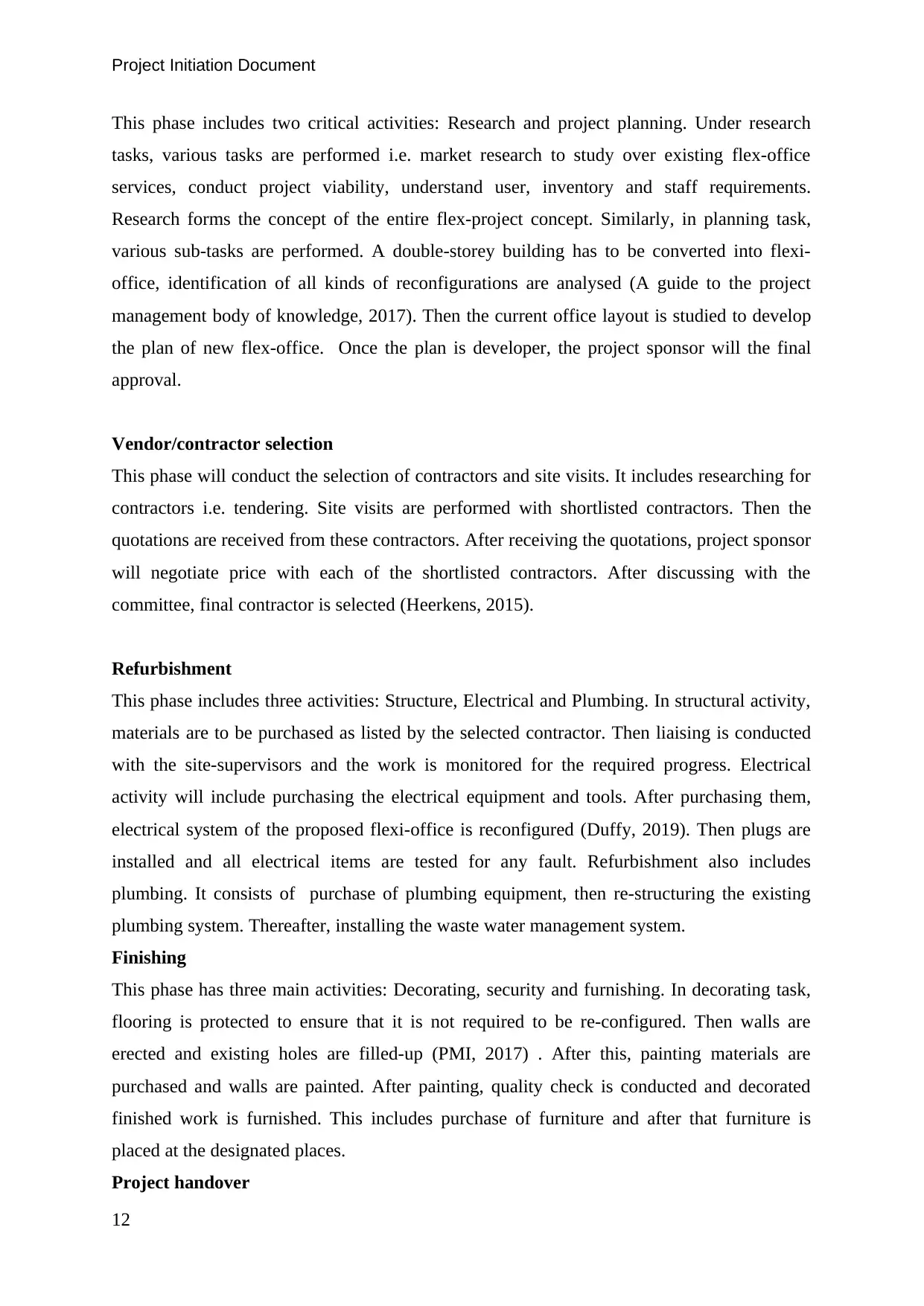
Project Initiation Document
This phase includes two critical activities: Research and project planning. Under research
tasks, various tasks are performed i.e. market research to study over existing flex-office
services, conduct project viability, understand user, inventory and staff requirements.
Research forms the concept of the entire flex-project concept. Similarly, in planning task,
various sub-tasks are performed. A double-storey building has to be converted into flexi-
office, identification of all kinds of reconfigurations are analysed (A guide to the project
management body of knowledge, 2017). Then the current office layout is studied to develop
the plan of new flex-office. Once the plan is developer, the project sponsor will the final
approval.
Vendor/contractor selection
This phase will conduct the selection of contractors and site visits. It includes researching for
contractors i.e. tendering. Site visits are performed with shortlisted contractors. Then the
quotations are received from these contractors. After receiving the quotations, project sponsor
will negotiate price with each of the shortlisted contractors. After discussing with the
committee, final contractor is selected (Heerkens, 2015).
Refurbishment
This phase includes three activities: Structure, Electrical and Plumbing. In structural activity,
materials are to be purchased as listed by the selected contractor. Then liaising is conducted
with the site-supervisors and the work is monitored for the required progress. Electrical
activity will include purchasing the electrical equipment and tools. After purchasing them,
electrical system of the proposed flexi-office is reconfigured (Duffy, 2019). Then plugs are
installed and all electrical items are tested for any fault. Refurbishment also includes
plumbing. It consists of purchase of plumbing equipment, then re-structuring the existing
plumbing system. Thereafter, installing the waste water management system.
Finishing
This phase has three main activities: Decorating, security and furnishing. In decorating task,
flooring is protected to ensure that it is not required to be re-configured. Then walls are
erected and existing holes are filled-up (PMI, 2017) . After this, painting materials are
purchased and walls are painted. After painting, quality check is conducted and decorated
finished work is furnished. This includes purchase of furniture and after that furniture is
placed at the designated places.
Project handover
12
This phase includes two critical activities: Research and project planning. Under research
tasks, various tasks are performed i.e. market research to study over existing flex-office
services, conduct project viability, understand user, inventory and staff requirements.
Research forms the concept of the entire flex-project concept. Similarly, in planning task,
various sub-tasks are performed. A double-storey building has to be converted into flexi-
office, identification of all kinds of reconfigurations are analysed (A guide to the project
management body of knowledge, 2017). Then the current office layout is studied to develop
the plan of new flex-office. Once the plan is developer, the project sponsor will the final
approval.
Vendor/contractor selection
This phase will conduct the selection of contractors and site visits. It includes researching for
contractors i.e. tendering. Site visits are performed with shortlisted contractors. Then the
quotations are received from these contractors. After receiving the quotations, project sponsor
will negotiate price with each of the shortlisted contractors. After discussing with the
committee, final contractor is selected (Heerkens, 2015).
Refurbishment
This phase includes three activities: Structure, Electrical and Plumbing. In structural activity,
materials are to be purchased as listed by the selected contractor. Then liaising is conducted
with the site-supervisors and the work is monitored for the required progress. Electrical
activity will include purchasing the electrical equipment and tools. After purchasing them,
electrical system of the proposed flexi-office is reconfigured (Duffy, 2019). Then plugs are
installed and all electrical items are tested for any fault. Refurbishment also includes
plumbing. It consists of purchase of plumbing equipment, then re-structuring the existing
plumbing system. Thereafter, installing the waste water management system.
Finishing
This phase has three main activities: Decorating, security and furnishing. In decorating task,
flooring is protected to ensure that it is not required to be re-configured. Then walls are
erected and existing holes are filled-up (PMI, 2017) . After this, painting materials are
purchased and walls are painted. After painting, quality check is conducted and decorated
finished work is furnished. This includes purchase of furniture and after that furniture is
placed at the designated places.
Project handover
12
⊘ This is a preview!⊘
Do you want full access?
Subscribe today to unlock all pages.

Trusted by 1+ million students worldwide
1 out of 13
Your All-in-One AI-Powered Toolkit for Academic Success.
+13062052269
info@desklib.com
Available 24*7 on WhatsApp / Email
![[object Object]](/_next/static/media/star-bottom.7253800d.svg)
Unlock your academic potential
Copyright © 2020–2025 A2Z Services. All Rights Reserved. Developed and managed by ZUCOL.

